Ring lights are popular in portrait, fashion, and macro photography, because they produce unique shadowless lighting effect. Ring Flash adapters are a great alternative to the big studio ring flashes, since they are more portable and typically priced at a fraction of the cost of the studio strobes (the speedlights are far less powerful, though).
Ray Flash was the one to pioneer the market of ring flash adapters. In the recent years, several manufacturers brought similar products to the market. Some of them are great and unique adapters, like RoundFlash or Orbis, whereas some of them are cheap knock-offs. The recently released Ray Flash 2 Universal Ring Flash Adapter is making another leap forward improving an already solid product. Let's take a closer look.
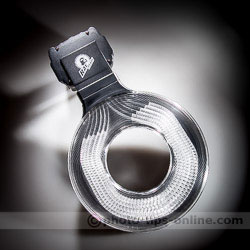 |
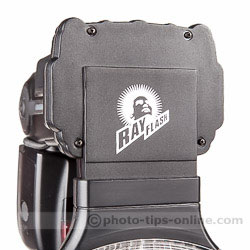 |
Ray Flash 2 has a sleek contemporary design. The construction is all-plastic, but it feels very sturdy. It has a noticeably lower profile than its predecessor, which makes it more portable. The ring itself is wider, which should produce softer light, but we'll get back to it in a bit.
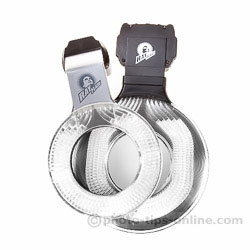 |
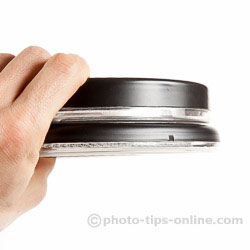 |
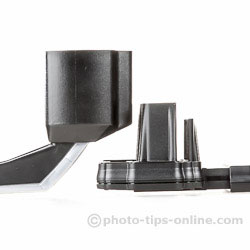 |
One of the drawbacks of the original Ray Flash was the custom attachment, which would only fit certain combinations of DSLR camera bodies and flashguns. There was about 10 different models on the market to fit the major professional level equipment from Canon and Nikon. Ray Flash 2 features a universal mount that fits virtually any flash head. We tested it with 7-8 different flashes, and they all worked perfectly with the new mount. With the spring-loaded padded clamp, Ray Flash 2 attaches not only securely but also quickly.
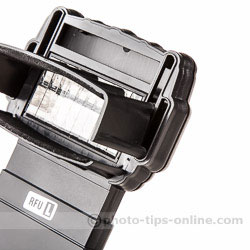 |
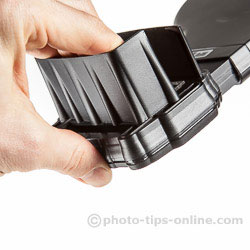 |
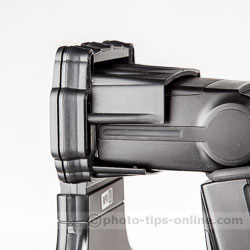 |
Even with the universal mounting, you need to choose between two versions of Ray Flash 2 depending on the size of your camera body. The taller cameras, like Canon 50D Mark III, Nikon D800, Pentax K7, and similar, should be used with Ray Flash 2 Long, whereas Ray Flash 2 Short is designed for smaller bodies, like Canon 1100D, Nikon D5200, Sony DSLR-A350, etc. There is fairly comprehensive list of compatible cameras for both Ray Flash 2 models on ExpoImaging.com (USA distributor of Ray Flash 2).
Another thing to note about the mounting of Ray Flash 2 is that, depending on your flash construction, the flash head can tilt down when this adapter is attached. As a result, the front surface of Ray Flash 2 may not be parallel to the front of the lens. As we mentioned in our original Ray Flash review, Ray Flash used to come with wedges that you could stick under the flash head. Ray Flash Universal offers a much more elegant solution to the problem. It comes with a rubber band that has three sections, and each section has its own thickness. We found that Canon Speedlite 580EX II should be used with the thinnest area of the rubber band. The middle section of the band works best, for example, with Phottix Mitros and Nissin Di866 II flashes.
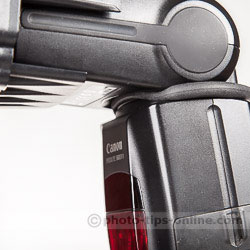 |
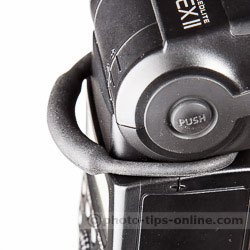 |
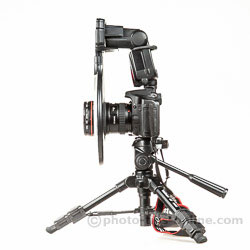 |
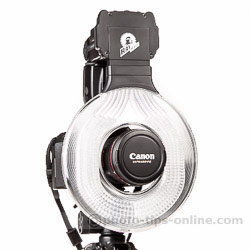 |
Ray Flash 2 has an adjustable ring that slides up and down, so you can center it around your lens. The proper position depends on the combined height of your speedlight and camera. However, we found that is not critical to perfectly center the ring. The light quality does not change much even when the ring is off center. Moreover, as you can see in the images below, the light guides actually stay in the same place in the relation to the lens even if the ring is repositioned.
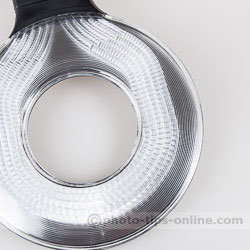 |
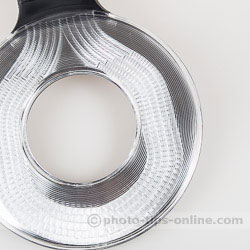 |
This brings us back to the note about the size of the ring, which we made in the beginning of the review. Even though the ring is fairly wide, the light is reflected forward mostly by the light guides themselves. So, the effective size of the ring is practically the size of the light guides, which is close to the original unit. This, in turn, means that the light quality of Ray Flash 2 is nearly identical to the light produced by its predecessor.
Similarly to the original Ray Flash, the light pattern of Ray Flash 2 suffers from two issues: "hot spot" and "dead spot". The top side of the ring is somewhat brighter ("hotter") than the rest of the ring. There is also a gap between the light guides at the top, so the ring of light is broken there. When the flash is fired, you can notice a darker triangle in the top part of the light pattern.
However, as you can see below, a simple modification can be done to improve the situation. Using a single sheet of paper and a tape, we were able to quickly create an attachment and get an almost perfect ring of light, eliminating both issues.
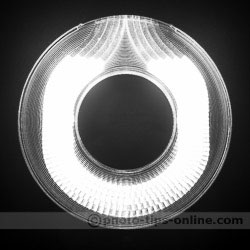 |
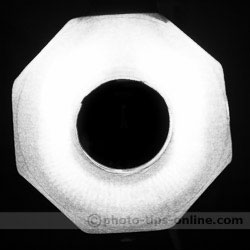 |
 |
 |
Let's not forget, however, that Ray Flash is famous for its light efficiency. In fact, out of all ring flash adapters on the market, it loses the least amount of light. As we show in our Orbis vs. Ray Flash comparison, Orbis loses about 3 f-stops more light than Ray Flash (that means 8 times less light for Orbis). This still stays true for the new Ray Flash Universal unit.
The paper mod we've made, obviously, increases the light loss. So, to have a complete and larger ring with a reduced hot spot, you need to pay with 1-2 f-stops of light output, depending on how you make the attachment. This is significant, but in some applications, we would be willing to sacrifice light efficiency for the improved light quality. We'd like to see the inventor of Ray Flash Dalibor Zyka come up with a diffusion attachment for his ring flash adapter, so photographers can choose between light quality and light efficiency, depending on their current task.
Speaking of the light efficiency, we want to add, that we found that Ray Flash 2 delivered the maximum light output when flash zoom was set to 50 mm. In our measurements, we saw the power decline by up to 1/2-stop (at 24 mm).
The "dead spot" we mentioned may or may not present a problem in real life applications depending on how and what you shoot. In the portrait below, you can clearly see the darker spot on the left, which, however, can be fixed in post-processing.
 |
In many cases, though, Ray Flash 2 delivers great light quality you'd want from a ring flash, and you can take beautiful photographs.
 |
 |
 |
 |
Ray Flash 2 works great not only for portraits, it is also very useful in macro photography. Here are just a couple of examples:
 |
 |
Finally, another change that Ray Flash 2 brings to its users is the price. The original unit was priced at $199 (USD), whereas Ray Flash 2 is just $139 (USD). That is 30 percent less money for a better product ;).
To conclude, Ray Flash 2 Universal Ring Flash Adapter is a great accessory for anyone who needs a portable ring flash light. It is not perfect and inherits some issues of its predecessor, but it is improved significantly. The universal mount, lower profile, sleek design, and lower price take the second generation of Ray Flash adapter to the next level, making it much more competitive. We believe that if the manufacturer comes up with some sort of a diffusion attachment for Ray Flash 2, it will strengthen the product position even further by giving it even more flexibility.